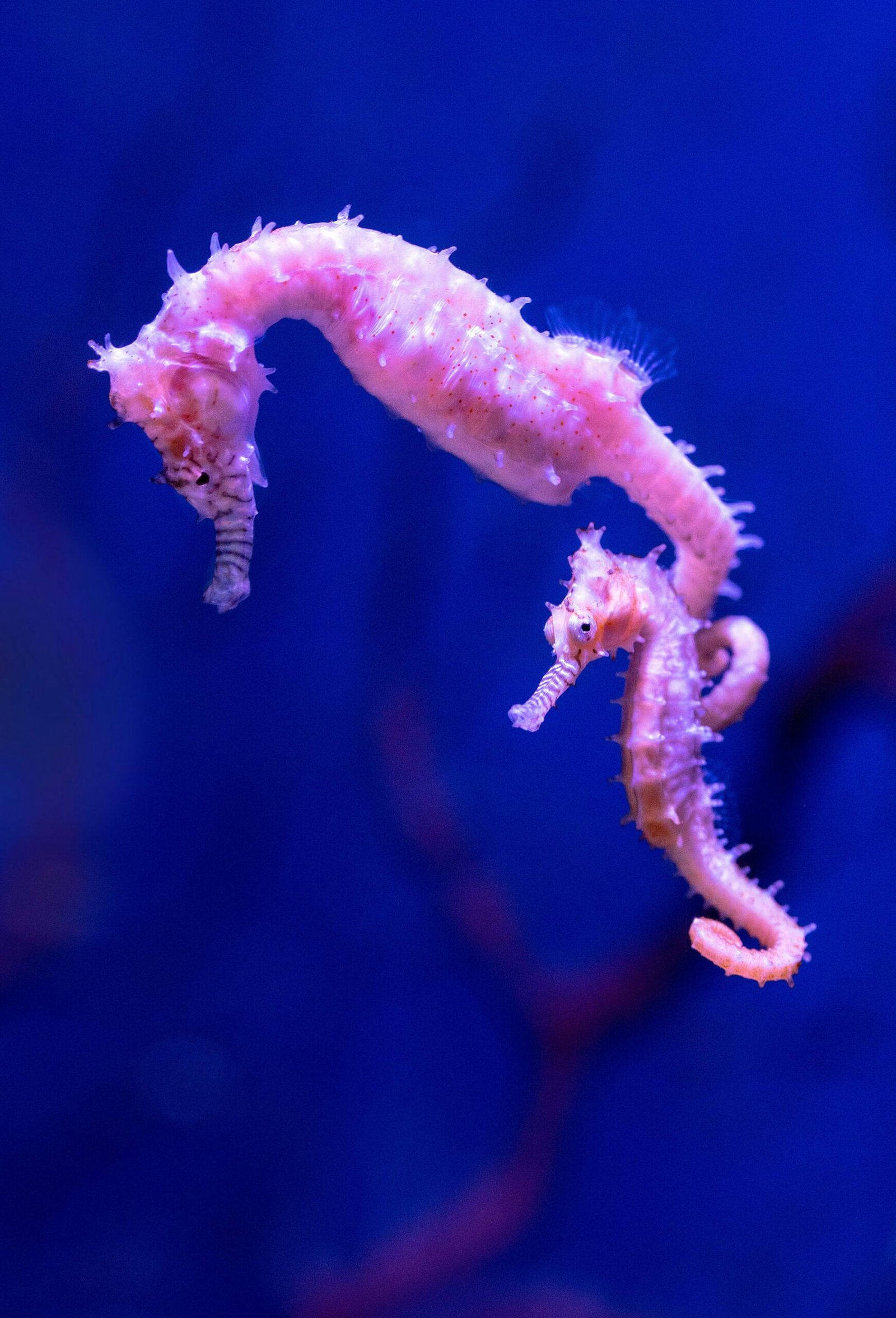The Enchanting World of Seahorses
Seahorses are fascinating creatures that have captured the attention of marine enthusiasts and researchers alike. They can be found in various parts of the world, including the warm coastal waters of the Pacific Ocean, the Indian Ocean, and the Atlantic Ocean. These enchanting creatures are known for their unique appearance, with their horse-like heads, long snouts, and curled tails.
Seahorses are not great swimmers like other fish; instead, they use their dorsal fin to propel themselves through the water. They are often found clinging onto seagrass or coral reefs, using their prehensile tails to anchor themselves and blend in with their surroundings. This camouflage helps them evade predators and ambush their prey.
Speaking of prey, seahorses have a rather peculiar diet. They mainly feed on small crustaceans, such as shrimp and plankton, which they suck into their tubular snouts. They have no teeth or stomach, so food passes through their digestive system quickly. Due to their small size and slow swimming speed, seahorses need to consume a large amount of food to sustain themselves.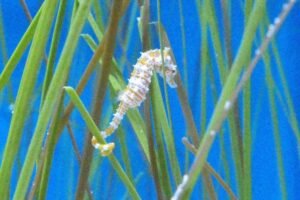
When it comes to lifespan, seahorses have relatively short lives compared to other marine species. On average, they live for about 1 to 5 years, depending on the species and environmental conditions. However, some larger species of seahorses have been known to live up to 10 years in captivity.
One of the most intriguing aspects of seahorses is their unique breeding habits. Unlike most other animals, it is the male seahorse that carries and gives birth to the young. After an elaborate courtship dance, the female deposits her eggs into a pouch on the male’s abdomen. The male then fertilizes the eggs internally and carries them until they hatch, which can take anywhere from a few weeks to several months.
Seahorses face numerous threats in their natural habitats. Habitat destruction, pollution, and overfishing are major concerns for their survival. In recent years, conservation efforts have been implemented to protect seahorse populations and their fragile ecosystems.
In conclusion, seahorses are truly captivating creatures with their unique appearance, feeding habits, and reproduction methods. Their ability to adapt to their surroundings and their role in maintaining the delicate balance of marine ecosystems make them an essential species to protect and conserve.
1. Habitat and Distribution
Seahorses are primarily found in shallow tropical and temperate waters around the world. They can be spotted in oceans, seas, and even in some freshwater habitats. These fascinating creatures are often found in seagrass meadows, coral reefs, mangroves, and estuaries.
Seahorses are known for their ability to camouflage and blend in with their surroundings. They often attach themselves to objects such as seagrass, coral, or mangrove roots using their prehensile tails. This allows them to stay in one place and avoid being swept away by strong ocean currents.
The specific habitat preferences of seahorses vary depending on the species. Some seahorses prefer seagrass meadows, where they can hide among the blades of grass and feed on small crustaceans and plankton that drift by. Others are commonly found in coral reefs, where they can find shelter among the nooks and crannies of the coral structure.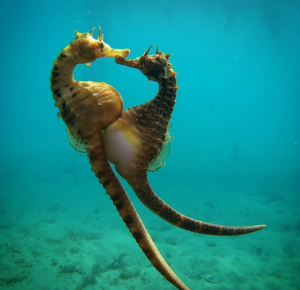
In addition to seagrass meadows and coral reefs, seahorses are also known to inhabit mangroves. These unique coastal ecosystems provide seahorses with a rich and diverse habitat. The tangled roots of mangroves offer seahorses plenty of places to anchor themselves and hide from predators.
Estuaries are another important habitat for seahorses. These transitional zones where rivers meet the sea are characterized by brackish water, which is a mix of fresh and saltwater. Seahorses are well adapted to these environments and can tolerate a wide range of salinities. They can often be found in the sheltered areas of estuaries, where they can take advantage of the abundant food sources.
While seahorses are primarily associated with marine environments, there are a few species that have adapted to freshwater habitats. These freshwater seahorses are found in rivers, lakes, and streams in regions such as Southeast Asia and South America. They have unique adaptations that allow them to survive in these freshwater ecosystems.
In conclusion, seahorses have a diverse range of habitats and can be found in various parts of the world. Their ability to blend in with their surroundings and their specialized appendages, such as their prehensile tails, allow them to thrive in different environments. Understanding the specific habitat preferences of different seahorse species is crucial for their conservation and protection.
2. Diet and Feeding Habits
Seahorses have a unique feeding strategy compared to other fish species. They are carnivorous and primarily feed on small crustaceans, such as copepods and shrimp larvae. Seahorses use their long snouts to suck in their prey, which is then swallowed whole.
Unlike most fish, seahorses lack a stomach, so they must eat frequently to meet their nutritional needs. They have a high metabolism and can consume up to 3,000 tiny prey items per day. This constant feeding behavior is necessary to compensate for their inefficient digestion process.
Seahorses have a fascinating way of hunting their prey. They have excellent eyesight and can spot their prey from a distance. Once they have identified a potential meal, they use their prehensile tail to anchor themselves to a nearby object, such as seagrass or coral. This allows them to remain stationary and conserve energy while waiting for their prey to come within striking distance. 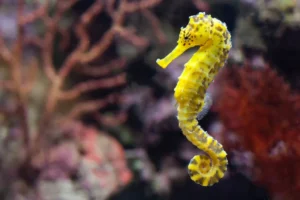
When a seahorse spots its prey, it slowly approaches it, using precise movements to avoid alerting the crustacean. Once it is close enough, the seahorse extends its snout and creates a vacuum by rapidly opening and closing its jaws. This sudden burst of suction pulls the prey into the seahorse’s mouth, where it is swallowed whole.
Seahorses have a remarkable ability to adjust their feeding behavior based on the availability of prey. If food is abundant, they will consume larger quantities in a shorter period. However, during times of scarcity, seahorses can go days without eating. They have the ability to slow down their metabolism and conserve energy until prey becomes more readily available.
In addition to copepods and shrimp larvae, seahorses may also feed on other small invertebrates, such as amphipods and small fish fry. Their diet can vary depending on their habitat and the specific prey species that are available to them. Seahorses are opportunistic feeders and will consume whatever is most abundant in their environment.
The unique feeding habits of seahorses make them highly specialized predators. Their ability to consume a large number of prey items per day allows them to meet their energy requirements despite their inefficient digestion process. This, combined with their remarkable hunting techniques, makes seahorses fascinating creatures to study and observe in their natural habitat.
3. Lifespan and Life Cycle
The lifespan of seahorses varies depending on the species and environmental factors. On average, seahorses live for about 1 to 5 years in the wild. However, some species have been known to live for up to 10 years in captivity.
Seahorses have a unique reproductive process that sets them apart from other marine creatures. The male seahorse carries the eggs in a specialized pouch until they hatch. This phenomenon is rare in the animal kingdom and makes seahorses one of the few species where the males take on the role of pregnancy and childbirth.
During courtship, male seahorses perform an elaborate dance to attract females. Once a pair forms a bond, the female deposits her eggs into the male’s pouch. The male then fertilizes the eggs internally and carries them until they are ready to hatch. This process can take anywhere from 10 days to several weeks, depending on the species.
When the seahorse fry are ready to emerge, the male undergoes muscular contractions to expel them from his pouch. The tiny fry are fully formed and immediately begin their independent lives, facing numerous challenges in their quest for survival.
The life cycle of seahorses is a fascinating journey filled with both triumphs and obstacles. After the fry are released into the water, they must navigate their way through a world teeming with predators and competition for resources. Their small size and delicate bodies make them vulnerable to larger fish, while their lack of swimming ability puts them at a disadvantage when it comes to capturing prey.
To compensate for these limitations, seahorse fry possess incredible camouflage abilities. Their bodies can change color to blend in with their surroundings, allowing them to hide from potential threats. They also have a unique body shape, with a curled tail that can anchor them to seagrass or coral, providing stability in turbulent waters.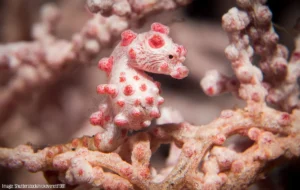
As the fry grow, they go through several stages of development. They molt their exoskeletons multiple times, shedding their old skin to accommodate their increasing size. Each molt brings them closer to adulthood, but it also leaves them vulnerable during the process, as they are temporarily defenseless without their protective outer layer.
Once they reach maturity, seahorses face the challenge of finding a suitable mate. They engage in courtship rituals, involving intricate dances and displays of strength and agility. The successful pairing leads to the transfer of eggs from the female to the male, initiating the cycle anew.
Overall, the lifespan and life cycle of seahorses are intricately intertwined with their unique reproductive process and the challenges they face in their environment. Understanding these aspects not only provides valuable insights into the fascinating world of seahorses but also highlights the importance of conservation efforts to protect these remarkable creatures and their fragile ecosystems.
